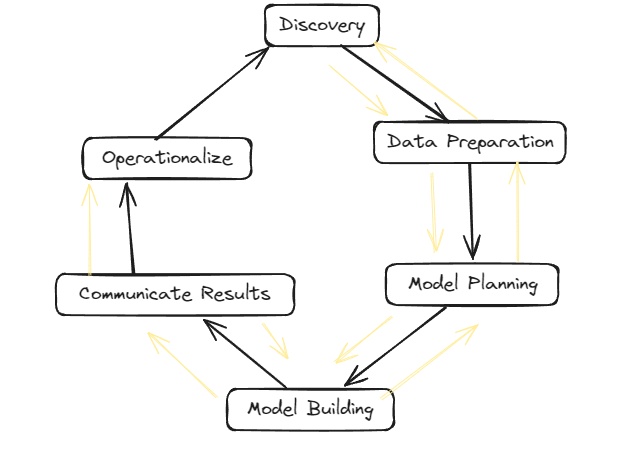
The data analytics lifecycle refers to the series of steps involved in the process of extracting insights and value from data. It typically consists of the following six stages:
- Discovery: In this stage, the goals and objectives of the analysis are defined. It involves understanding the problem domain, identifying the key questions to be answered, and determining the scope of the analysis.
- Data Preparation: Data preparation involves collecting, cleaning, and preprocessing raw data to make it suitable for analysis. This stage includes tasks such as data integration, data transformation, dealing with missing values, and removing outliers.
- Model Planning: In the model planning stage, the analytical approach and techniques to be used for data analysis are selected. This involves choosing the appropriate models, algorithms, and methodologies based on the nature of the problem and the available data.
- Model Building: Model building is the stage where statistical or machine learning models are developed using the prepared data. This involves training the models, tuning parameters, and evaluating their performance using various metrics.
- Communicate Results: Once the models are built and evaluated, the results of the analysis need to be communicated effectively to stakeholders. This stage involves visualizing the findings, interpreting the results, and presenting insights in a clear and understandable manner.
- Operationalize: Operationalizing the results involves deploying the analytical models into production systems to make data-driven decisions and take actions based on the insights generated. This stage may involve integrating the models with existing business processes, monitoring their performance, and updating them as needed.
Why is the Data Analytics Lifecycle Essential?
The data analytics lifecycle is essential for several reasons:
- Structured Approach: It provides a structured and systematic framework for conducting data analysis, ensuring that all necessary steps are followed in a logical sequence. This helps prevent overlooking critical aspects of the analysis and ensures that the results are reliable and actionable.
- Quality Assurance: Each stage of the lifecycle includes checks and validations to ensure the quality and integrity of the data and the analysis. This helps identify and address any issues or errors early on, leading to more accurate and trustworthy results.
- Optimization of Resources: By following a lifecycle approach, organizations can optimize the use of resources, including time, personnel, and technology. It helps prioritize tasks, allocate resources efficiently, and avoid unnecessary rework or duplication of efforts.
- Effective Decision Making: The data analytics lifecycle facilitates effective decision-making by providing insights and actionable recommendations based on data-driven evidence. It helps organizations gain a deeper understanding of their operations, customers, and market dynamics, leading to informed and strategic decisions.
- Continuous Improvement: The lifecycle approach promotes continuous improvement by enabling organizations to learn from past experiences and refine their analytical processes over time. It allows for feedback loops and iterative refinement of models and methodologies to adapt to changing business needs and evolving data landscapes.
- Alignment with Business Objectives: By aligning the data analytics process with business objectives and goals, the lifecycle ensures that the analysis delivers value and contributes to achieving organizational priorities. It helps prioritize analysis efforts and focus on areas that have the greatest impact on business performance and outcomes.
Team Answered question April 8, 2024
